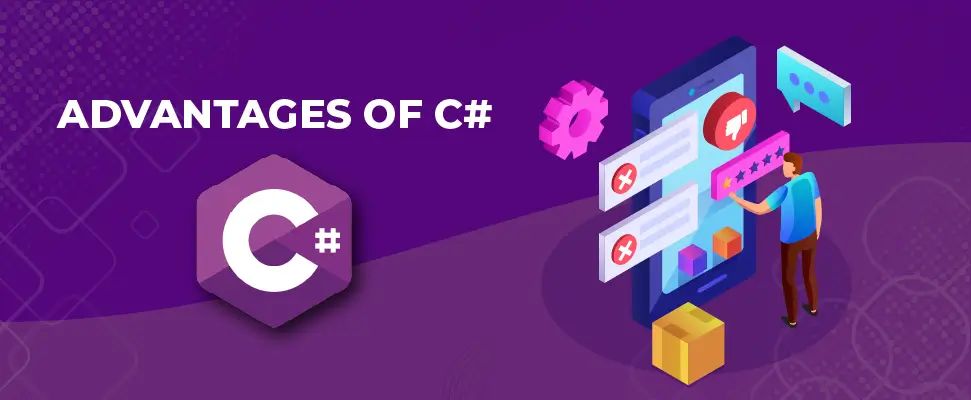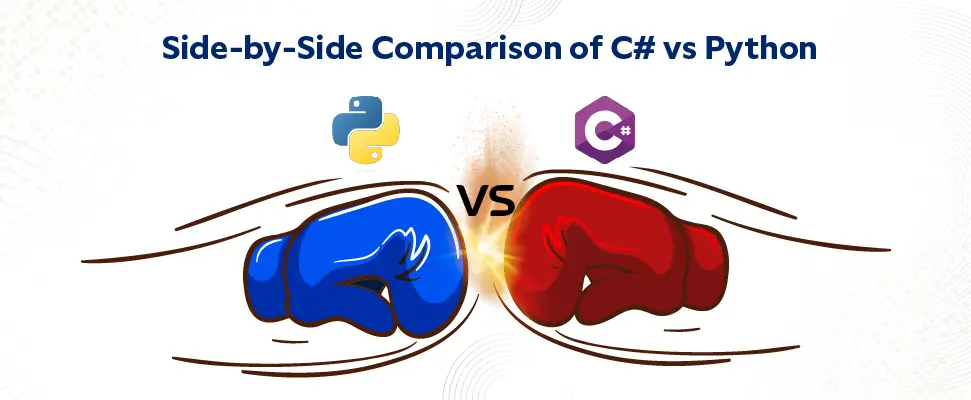Table of Contents
ToggleIntroduction
Python with its syntax, akin to the English language captivated both experienced programmers and individuals with non-programming backgrounds. It has become the “Trendsetter” in the programming world. The best part is its built-in module that can do almost every task. It has also earned quite a name in data science, machine learning, and artificial intelligence. But that being said, Python is not a one-fit-all solution. There are many popular programming languages to choose from and C# stands out among them. It is a versatile language widely used in various domains.
According to the Statista data of 2023, Python ranks 3rd with 49.28%, and C# ranks 8th with 22.42% of developers using it globally. C# is best suited to build enterprise-level applications and system software for industry. Similarly, Python is well-suited for projects with computational tasks, data scientists, and research analysts.
This article will explore the differences between these two programming languages suitable for different projects.

Don't miss out on your chance to work with the best!
Apply for top job opportunities today!
Overview of Python and C#
C# and Python are widely popular in different kinds of projects. Developers and programmers around the globe widely use these languages in software development.
C# is one of the members of the C family and is considered a modern language among them. C# is primarily used to develop Windows desktop apps. It is statically typed, meaning before using any data type or variable, it should be defined explicitly. This makes C# programs less verbose and less likely to get runtime errors. Additionally, it supports multiple programming styles including event-driven, functional, and object-oriented programming. It’s no surprise that C# is used in diverse projects.
Python, on the other hand, is an easy to learn language with no extra fuss. It offers extensive libraries of modules and endless customization options that can largely help experienced programmers and novices bring new ideas into their projects. Python is a dynamically typed language, meaning programmers don’t need to declare its data type of variable explicitly, instead, it is determined during the runtime. Furthermore, it provides a large collection of standard libraries, frameworks, and third-party tools, making it a top choice for data science, scientific computing projects, deep learning, machine learning, and artificial intelligence.
Advantages of Python

Python is widely used in various domains due to its simple and flexible nature. Some of its domains include healthcare, scientific research, healthcare, technology, and finance. Let’s take a closer look at its advantages:
- Promotes rapid prototyping and production-ready software.
- Easily integrates with other programming languages like C++, C, and Java.
- Seamless connection with database systems including SQL server, Oracle, and PostgreSQL,
- A go-to choice for developers who want to develop applications on multiple platforms
- Interpreted language that is developer-friendly.
- Best programming language to develop web frameworks, some of the prominent examples are TurboGears, Flask, and Django.
- Most suitable language for building large-scale applications.
Real-life Use cases of Python
- Pinterest: A well-known image social networking platform that uses Python to handle large amounts of content.
- Spotify: One of the renowned music streaming services relies on Python advanced data analytics and speed.
- Dropbox: A widely popular file hosting company that uses Python for its rapid development and cross-platform support.
- Uber: This famous book “My Ride” app was developed using Python; since Uber needs accurate calculations for every ride and Python excels it. None of the programming languages can surpass Python in this regard.
Advantages of C#

C# has a strong backup with Microsoft technologies. The following are some of its noteworthy advantages:
- Supported by Visual Studio and widely used in Microsoft IDE.
- C# in combination with .Net Core can be used for cross-platform development.
- A primary choice for developing games on various platforms; one of its popular game engines is Unity.
- Emphasizes more on type safety features and memory management
- Continuation improvements have given C# a competitive edge with modern programming language.
- C# easily integrates with Microsoft technologies which is a plus point for enterprises and businesses.
- Productivity is improved with the Language Integrated Query (LINQ).
Applications and Websites Built Using C#
- Unity Game Engine
- Stack Overflow
- Microsoft Azures
- Visual Studio IDE
- MyFitnessPal
Difference Between Python and C#
| Python | C# |
|---|---|
| It uses tuple expressions | It particularly doesn’t have the tuple expression but does support it in the form of regular classes |
| Objects are dynamic, developers can add their tags to objects through monkey patching | C# is less dynamic, to achieve the same would require dependency injection and extension method, which is a complex process |
| Dynamically typed interpreted language | Statically typed object-oriented language |
| The concept of multithreading is restricted due to the use of Global Interpreter Lock (GIL) but it supports single threading | Supports multiple threading |
| It lacks the native support for generic and structs | Structs and generic is supported by default |
| Yield expression in Python can accept values and return them as well | Yield expression in C# can only accept the value through asyn/wait |
| Python lacks the LINQ feature, but it provides a list of comprehension | It supports LINQ, which enables developers to use expressive queries and transform data |
| It offers flexibility in handling variable arguments using args and kwargs | It also offers various ways to pass the argument through the .Net remoting architecture and dynamic objects. But the process is quite complex compared to Python |
| Python does not support parallel processing and concurrency | C# has robust support for asynchronous programming that allows tasks in parallel library and parallel LINQ |
| It does not use the concept of interface | It uses an interface to maintain the code and flexibility |
Side-by-Side Comparison of C# vs Python

This brings us to the main topic of discussion, the difference between these two phenomenal languages. Let’s dive right into its points:
C# vs Python: Syntax
Although C# shares its origin with C and C++, it shares similar characteristics and features with Java. Just like Java, C# is case-sensitive and while writing a program one needs to be extra careful with the uppercase and lowercase. The following is a simple example of “Hello World” using C# code and syntax.
using System;
namespace HelloWorldProgram
{
public static class Program
{
static void Main()
{
Console.WriteLine(“Hello, World!”);
}
}
Unlike C#, Python has simple and readable syntax, someone who doesn’t have prior experience can write and understand it within a month. The most important thing to note is that Python’s variable is case sensitive, meaning variable “a” and variable “A” are not the same variable in Python, instead, it is considered different. Have a look at the following “Hello World” syntax created using Python code.
Basic program
print (“Hello World”)
Using sys module
import sys
sys.stdout.write(“Hello World”)
Using string variable
message = “Hello, World!”
print(message)
Using f-string
print(f”Hello, World!”)
Source code Geeks for Geeks
C# vs Python: Performance
Python heavily relies on the interpreter. C# code is parsed and translated into Common Intermediate Language (CIL) using the Common Language Runtime (CLR), which then translates into machine code. In Python, each line of code needs to be interpreted and executed, which makes things a little complex. Generally, interpreted languages are slower in comparison with complied language. However, C# also doesn’t directly get translated into machine code, it goes through an extra step from CIL to CLR. Thus, in terms of performance, both languages are on the same page.
But surprisingly, that’s not correct, especially these days; computers process things quickly, due to which, the time delay of C# is so little that users won’t even come to know it. The CLR process does take a lot of time, but Just-in-Time (JIT) compiles the code directly to machine code. Also, the CLR cache copies the code that has already been translated. So, whenever the same code is executed, it doesn’t translate again.
Therefore, the performance of C# is much faster than Python. In some cases, Python can be used along with its fast libraries to maximize its speed. But in uncommon scenarios, C# performance can also slow down.
C# vs Python: Libraries and Ecosystem
Both of the languages boast their vast tools and libraries. But C# is limited to the .Net framework and heavily relies on its standard library. Some of the libraries that C# offers are Entity Framework, Xamarin, ASP.Net Core, and .Net Core. Using this library, developers can work seamlessly under the Microsoft ecosystem.
Python offers libraries and frameworks such as Pandas, Keras, TensorFlow, Bottle, SciPy, Flask, NumPy, Django, PyTorch, and Pyramid. These provide additional features to create a wide range of applications with ease.
C# vs Python: Development Speed
Python’s dynamic typing and simple syntax make code super easy which leads to faster development than C#. Its extensive libraries allow developers to reuse the existing code. This is extremely useful for projects that require rapid prototyping.
However, C# is a complied language that provides exceptional speed during runtime performance.
Python vs C#: Salaries
| Python | Salaries | C# | Salaries |
|---|---|---|---|
| Python Developer | ₹4,65,000/yr. | .Net/C# Developer (Software Engineer) | ₹5,80,160/yr. |
| Data Analyst | ₹5,74,751/yr. | Senior C#/.NET Developer salaries | ₹15,57,808/yr. |
| Data Scientist | ₹95, 080 -11,37,500/yr. | C# Game developer | 5.9 Lac per year (₹49.4k per month) |
| Machine Learning Engineer | 8 lacs to 14 lacs/yr. | C# developer with 1-4 years of experience | ₹540,000 – ₹750,570 |
| Artificial Intelligence Engineer | 7 lacs to 15 lacs/yr. |
Final Thoughts
Deciding between these two languages can be tricky as both have unique strengths. To choose between these two languages, it’s important to note that Python lets you write programs without declaring any function. This programming approach helps to grasp the concept easily for both experienced programmers and non-experienced ones. But in C#, without clarity of classes, methods, basic syntax rules, namespace, and access specifiers such as public, private, and protected. One cannot begin to write the programs; these are the building blocks of C#. Thus, one needs to be clear with the basic concept before writing the program in C#.
Apart from that, Python standard libraries are filled with functions with fewer classes. And the best part is you don’t need to deal with the concept of inheritance in Python. In C#, base libraries are mostly classes and sometimes require you to understand the deep concept of inheritance. On top of that, writing a C# program one must be familiar with the .NET framework and Visual Studio. This makes it extra challenging to learn, especially for those who are from non-programming backgrounds. For this reason, Python is way easier to learn than C#.
In project terms, C# makes an ideal option for building large enterprise-level applications and Windows development. Python is an excellent option for data analysis, scientific computing projects, and simple scripts. However, C# has the upper hand in performance, due to which, it best aligns in video games and mobile development.
Whereas Python largely benefits from its extensive libraries and large active community. Moreover, both languages support objected-oriented features thus, they are also great choices for Machine Learning and AI. However, Python offers more libraries and built-in features, making it the preferred choice for ML/AI and data analysis
Take control of your career and land your dream job!
Sign up and start applying to the best opportunities!

FAQs
No, Python and C# are the mainstream languages there’s no chance that one will be replaced by another. These languages are widely used in software development to build a diverse range of applications. Python cannot handle some of the tasks that need concurrent operations due to Global Interpreter Lock (GIL). Whereas C# with its fast virtual machine can handle it efficiently. Therefore, none of the languages can replace one another.
You can use both, as C# offers ML.Net libraries for ML. It can read TensorFlow/ONIX libraries to train and build models. But it requires writing lengthy code in C# and it also lacks the robust features and functionalities that are needed more in ML/AI. Whereas, Python has plenty of options such as Keras, Gensim, Scikit-learn, TensorFlow, OpenCV, Pytorch, NLTK, and Pandas. With these many libraries, Python makes attractive options for AI/ML. Whereas C# is bound to follow the old-fashioned rules of Microsoft, it doesn’t necessarily make a bad option for AI/ML. Nevertheless, Python takes the spot of “favorite language” for AI/ML.
Yes of course you can, Python interoperability feature allows cross-language development. IronPtyhon and pythonnet run under the .Net Framework.
To determine the difficulty level depends on the prior programming skills and familiarity. But Python has fewer complex concepts than C#, which can reduce the learning curve for beginners.

